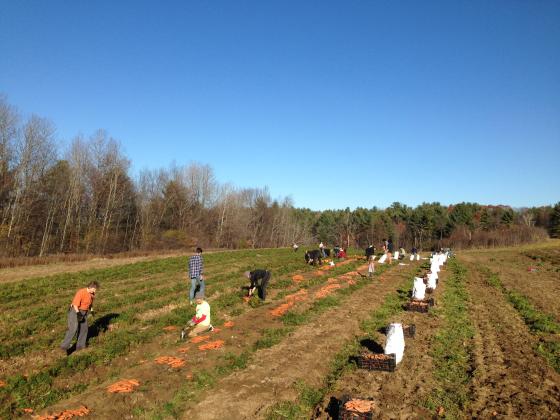Posted July 6, 2017 at 11:22am by Marcella Houghton
UVM students measure water and fuel costs of un-sold Vermont crops

UVM students measure water and fuel costs of un-sold Vermont crops
A team of UVM undergraduates recently partnered with Salvation Farms, a Morrisville nonprofit, to calculate some of the environmental costs of crop loss in Vermont. Their report, An Analysis of the Environmental Impact of Food Loss on Farms in Vermont, found that 140 million gallons of water and upwards of $20,500 worth of fuel (8,000 gallons) is used per year to grow crops that never make it to people.
These findings add new dimension to the value of Vermont’s surplus crops. In a 2016 study based on farmer surveys, Salvation Farms estimated that 14.3 million pounds of edible, Vermont-grown vegetable and berries are “lost” – unharvested or unsold – per year. The UVM students based their calculations on these crop loss numbers as well as Vermont-based models for agricultural water and fuel use.
Measuring the costs of food loss beyond simply the pounds of food mirrors national analysis on the topic. ReFed, a multi-stakeholder nonprofit, notes that food loss/waste across the food chain consumes 21% of all fresh water, 19% of all fertilizer, and 18% of cropland, costing $218 billion a year. “Identifying the resources lost when edible crops are left on our state’s farms, beyond the nutrition that could benefit people, shows the environment conservation potential that moving currently lost food to people can have” says Theresa Snow, Executive Director of Salvation Farms. “We are very grateful for the work this student group did for Salvation Farms.”
The students’ findings support the need to create supply chain practices and improvements to manage surplus crops. “Utilizing limited resources effectively is an important aspect of promoting a healthy environment. When millions of gallons of water and fossil fuels are used to produce crops which are not consumed, those resources cannot be used to support the people and places that need food,” states the study’s conclusion. “Rather than allowing these resources to be lost in the form of unused food, using edible but unmarketed surplus to feed people is an important alternative.”
Photo Caption: A field of volunteers gleaning carrots in Addison County, VT in fall 2016, led by H.O.P.E.’s gleaning program in partnership with two other gleaning groups. The farmer donated 9,000 pounds of carrots that otherwise didn’t have a market – an example of the volume possible with surplus crops.
